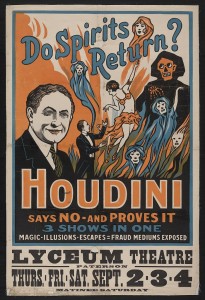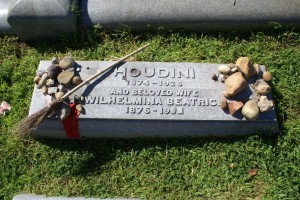The subtitle of the show is “Art and Magic,” but the word that haunted me when I visited “Houdini,” an exhibit at the Jewish Museum of Art in New York City, was science.
The magic was certainly there. The handcuffs that couldn’t hold him. The straitjacket that couldn’t contain him. The thrilling films of Houdini diving handcuffed into a river in Rochester, only to surface, unshackled, after barely a moment, or dangling straitjacketed upside-down over lower Manhattan, pupa-like, wriggling until he’s free.
The art was there, too. The original playbills. The original posters. The derivative paintings and sculptures that, over the past century, have appropriated the iconography of Harry Houdini.
Present, as well, were sociological explanations of why the show was at the Jewish Museum. Harry Houdini was born Erich Weiss, in Budapest, and his family emigrated to Appleton, Wisconsin. “Houdini’s career and performances,” the museum’s website explains, “embodied key elements of the American archetype: hard work, ingenuity, modernity, and renewal.”
Yet as I walked through the galleries, I found myself thinking not about magic and art or about magic and sociology but about magic and science. When we watch magicians work, we don’t think they possess the power to make elephants actually disappear. We don’t believe the lady is being sawed in half. We don’t wonder how a quarter got into our cochlea. Instead, we sit there staring at the magicians and thinking, “How’d they do that?”
That gut-level impulse is the same as the scientist’s. The scientist doesn’t think of rain as angels’ tears, or the night sky as the playground of the gods, or the diversity of species as beyond comprehension. And when confronted with something that is seemingly beyond comprehension—if a dropped glass were to fall up, for instance—they wonder, “How’d it do that?” And they go about trying to figure out how, exactly.
But then I reached the chronological point in the exhibit corresponding to Houdini’s late-career interest in the supernatural. “Do Spirits Return?” reads one of the posters. “Houdini says NO – and PROVES IT.” My immediate thought was, “Well, no; he didn’t prove it.”
I tried to give him the benefit of the doubt. The poster dates from 1926, so Karl Popper’s invocation of falsifiability in science—that for a prediction to be scientific, you need to be able to prove it false, not true—was still a decade or so in the future. Not that falsifiability is philosophically airtight. As Adam Gopnik points out in his book Angels and Ages, “The usual response of a theorist who has predicted that all swans are white, when faced with a black swan, is not ‘Look, my idea is wrong!’ but ‘You call that a swan?’” And not that logical positivism, however viable, would have penetrated the culture all the way down to a promotional poster. Still, the idea that you can’t prove a negative had been around forever. Houdini couldn’t “prove” that spirits will never return because, well, what if one did?
Which is precisely what got Houdini interested in spiritualism: one returning spirit.
He didn’t set out to debunk spiritualism, at least at first. Houdini wanted it to work. He wanted to find that spirits really do return. He wanted to contact his mother, who died in 1913. Like his audience’s response to one of his escapes or illusions, his impulse at a séance would be to ask, “How’d they do that?” Unlike his audience, however, he wanted the answer to be, just this once, “I can’t possibly imagine.”
But when he started visiting mediums, he found he could see through their ruses. Better than anyone, Harry Houdini could identify the tricks of lighting, the misdirections, the sleights of hand. He endured years of literal disillusionment—of not being able to sustain the illusion of spiritualists as the ambassadors of spirits—until he began devoting himself, in print and on stage, to exposing the charlatans and revealing their methods. And in the end he succumbed to the fallacy that, decades later, Carl Sagan would characterize as mistaking the absence of evidence for the evidence of absence.
Less than two months after his “Do Spirits Return?” performances at the Lyceum Theatre in Paterson, N.J., Houdini was dead of a burst appendix. Since then, magicians and the curious have gathered at his gravesite in Queens, N.Y., on or near the anniversary of his death—Halloween—to see if he might send a message from the beyond. So far Houdini has been silent. And I suspect he always will be.
But I can’t prove it.
* * *
“Houdini: Art and Magic” is at the Jewish Museum of Art in New York City through March 27; it will travel to Los Angeles, San Francisco, and Madison, Wis.
Images: Library of Congress Prints and Photographs Division (upper); Anthony22 (lower).


We in Australia would start with the premise “all swans are black” and on seeing a white one go WTF
Always a valuable scientific response.